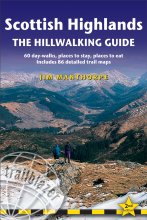Guides that will send you packing.
— Today

Scottish Highlands Hillwalking guide
Excerpt:
Introduction
Contents list | Introduction | Munros | Accommodation | Food & drink | Sample route guide: Suilven

'Thousands of tired, nerve-shaken, over-civilized people are beginning to find out that going to the mountain is going home; that wildness is a necessity'
John Muir, Wild Wool, 1875
The Highland region of Scotland is rightly considered to contain some of the most breathtaking landscapes in Europe. It is the largest upland area in the British Isles and, despite the modest height of the hills when
compared to other European ranges, is home to some incredibly diverse mountain architecture from the high sub-Arctic plateau and deep corries of the Cairngorms to the knife-edged ridges of the Skye Cuillin. Add to this the tumbling burns and rivers, ancient Caledonian pine forests and the magnificent islands and sea lochs (lakes) along the West Coast and you have a picture of what the Highlands have to offer.
It is perfectly possible to spend a lifetime walking these hills and many people do. Recreation in the mountains has become increasingly popular over the past ten to twenty years leading to the formation of a number of official long-distance paths, notably the West Highland Way and Great Glen Way. But to appreciate fully this diverse mountain region, the history, the wildlife and the ever changing light there can be no better way than to don a pair of walking boots and climb to the tops.
A hugely popular activity among British hillwalkers is to ‘bag’ the munros, the 284 Scottish summits of 3000ft or more. To limit oneself to these mountains alone, however, is to miss out on some of the most beautiful peaks that Scotland has to offer.
Despite the popularity of the Highlands, it is still possible to walk for days in the mountains without seeing another soul, making this the premier mountain region in the UK when compared to the English Lake District or Welsh Snowdonia, which are altogether busier and much smaller in area.
The Scottish hills certainly have a wild character but they are far from untouched. Man has over the centuries upset the balance of nature in this fragile environment. The most notable change to the landscape has come through the loss of the ancient Caledonian pine forest that once filled many of the glens. Today around 1% of this woodland remains in vulnerable fragments. Efforts are being made to encourage natural regeneration but this is hampered by the grazing activities of the red deer that roam the hillsides. Their population has exploded following the eradication of the wolf by man around 300 years ago. The high peaks and ridges above the treeline, however, have changed little or not at all since the last Ice Age, some 10,000 years ago. A walk up there is the closest you can get to finding true wilderness in the British Isles.
The great wonder of the Highlands is how the mountains change in character over such a short distance. The tamest hills are in the south around beautiful Loch Lomond which spills out into the Lowlands. In the east, the massive high-altitude Cairngorm plateau cut with deep corries is home to arctic wildlife and semi-permanent snowfields, a marked contrast to the west coast which is a land of narrow ridges, pyramidal peaks and fjords. Even further west, the Isle of Skye offers the most challenging and vicious-looking peaks in Britain in the shape of the Cuillin Hills, while the Outer Hebrides contain much smaller, rounded hills that look down on deserted white-sand beaches. Finally, in the far north, there is some of the remotest and wildest country, inselberg peaks rising as lonely sentinels from a vast lochan-studded floor.
The tops of many of these hills are relatively easy to attain while others require a certain level of ability, expertise and in some cases climbing experience. This book offers a selection of some of the best hill walks from each region of the Highlands. Some are straightforward walks of just a few hours while others are much longer and may involve a spot of scrambling or extra reserves of energy and fitness. The hills chosen for this book have been selected not just for their aesthetic quality but also to cover different levels of difficulty so that anyone with at least some hillwalking experience will find some walks within these pages to suit their ability. Additionally, as anyone who enjoys the mountains should have an innate regard for the natural environment, most of the hills in this book are easily accessible by public transport, so you can leave your four wheels at home!
Scottish Highlands Hillwalking guide
Excerpts:
Price: £13.99 buy online now…
 Shopping Basket
Shopping Basket
Latest tweets